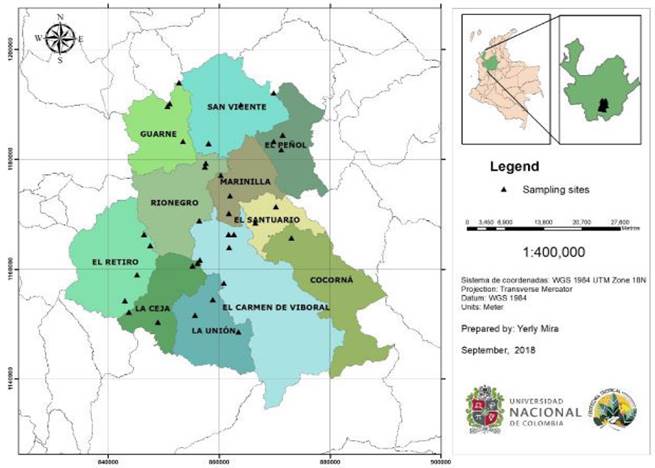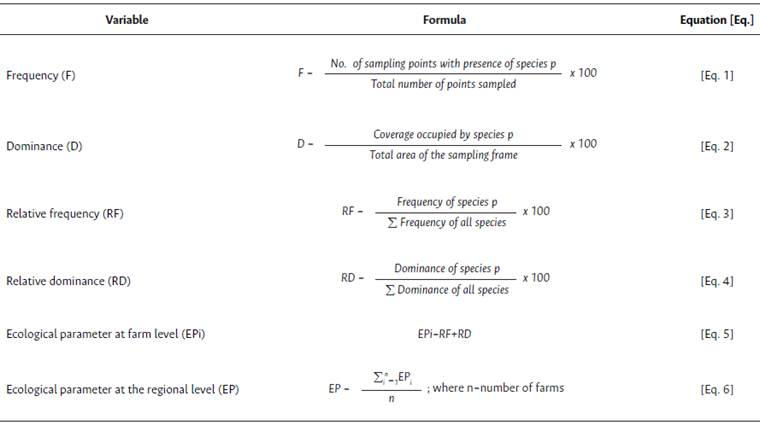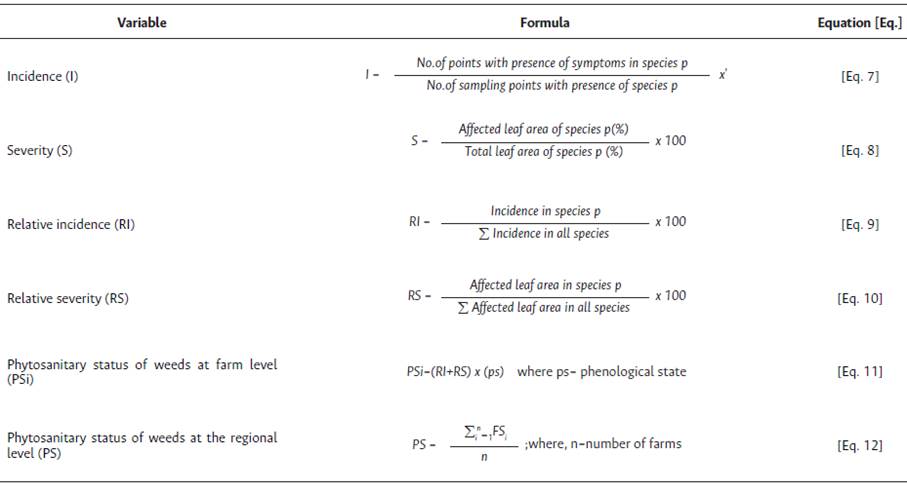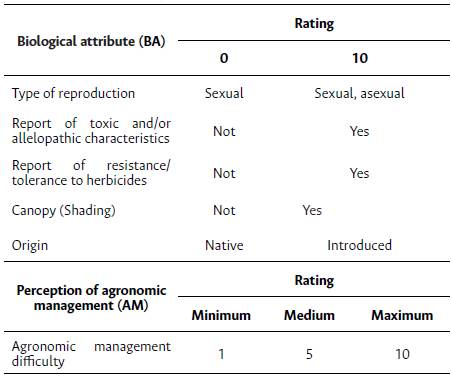INTRODUCTION
Weeds are considered undesirable in agricultural production, mainly due to the interference they generate with cultivated plants, either by direct competition for resources or by other aspects such as hosting pests and diseases, hindering harvesting work, increasing production costs, among others (Rao et al., 2018). Worldwide, it is estimated that approximately 30% of the losses of the main crops are caused by weeds (Jabran et al., 2015). The intensity of and dependence on chemically synthesized herbicides for their control have generated serious ecological alterations, effects on human health, and an increase in cases of weed biotypes with resistance to herbicides (Abbas et al., 2018). Currently, there are about 496 cases of herbicide-resistant weeds, affecting 92 crops in 70 countries; Furthermore, resistance is recorded for 23 of the 26 biochemical sites of herbicide target action (Heap, 2021). This situation represents a challenge for crop protection, the development of sustainable agriculture, and food security and safety.
In recent years, biological control of weeds has gained special interest considering the use of phytopathogenic fungi as potential and useful biological agents for weed control (Schwarzlander et al., 2018). The implementation of a weed biological control program requires in the first place, choosing an appropriate weed candidate using basic selection criteria such as the difficulty of its control through conventional methods, development of resistance to herbicides, and enforcing the prohibition of their use and/or prohibitive costs (Peschken & McClay, 1995). Other important factors to consider include the type of plant reproduction, growth habits, genetic heterogeneity, and even political and economic aspects.
Selected fungal strains are widely used for the biological control of insect pests, diseases, and weeds. Approximately 63% of investigations of biological control of weeds employing fungi or their natural molecules, were carried out on species of the Asteraceae, Poaceae, and Fabaceae families; highlighting the genera Amaranthus, Echinochloa, Aeschynomene, Cyperus, Eichhornia, and Malva (Triolet et al., 2019). The most studied plant genera in this area of research correspond to the most problematic weeds mainly for crops. Therefore, it is essential to know the composition of weed species present in crops in the local environment, the problems associated with each of these, and the biological, ecological, and anthropic characteristics that allow them to play a certain role in the agroecosystem (Scavo & Mauromicale, 2020). Depending on these aspects and the particular spatial and temporal environmental conditions, it is possible to find species classified as with low or high interference to crops, invasive, green cover, among others. On the other hand, 10 or more than 150 fungal isolates can be found in a single target weed; therefore, it is important to know and promptly detect those causing symptoms in the field, which could provide candidate pathogens for obtaining possible bioherbicides (Castro et al., 2017).
There is little knowledge about various aspects of associated weed plants in crops grown in the east of Antioquia, Colombia, which has made their correct management difficult. The integration of biological, ecological, technical, phytosanitary, and other knowledge can contribute to optimizing and directing the design of integrated management strategies of weeds. The objective of this research was to determine the ecological, phytosanitary, and agronomic status of the weed flora associated with crops cultivated in the east of Antioquia, Colombia, and their potential to be chosen as candidates for biological control studies using pathogenic fungi.
MATERIALS AND METHODS
Study area
The study was carried out in different crops distributed in 11 municipalities in the east of Antioquia, Colombia, which are located in the central mountain range of the Andes, with altitudes between 1.900 to 2.600 m.a.s.l., with temperatures between 12 and 20°C and an average annual rainfall of 2.490 mm. According to the Holdridge (1982) classification, the region has four life zones: premontane humid forest, premontane very humid forest, lower montane humid forest, and lower montane very humid forest. The local soils are classified in the order of Andisols with the presence of volcanic ashes, high acidity, and aluminum saturation, high organic matter, and phosphorus retention; as well as reliefs made up of high and low hills, terraces, and plains (IGAC, 2007) (Figure 1). Thirty-five farms were selected, which were georeferenced with a Garmin map 62 cs GPS. Crops established on these farms and their proportion of participation in the survey corresponded to avocado 37%, vegetables 20%, tree tomato 8%, blackberry 8%, beans 6%, flowers 6% and corn, strawberry, aromatic plants, potato, and passion fruit with 3% each.
Floristic composition of weeds
Twenty sampling points were randomly distributed in each selected farm. The evaluation was carried out with a 0.25 m2 sampling frame. At each point, a visual assessment of the total canopy cover percentage present in the frame was assigned and represented cover percentages were determined for each weed. For weed identification, a biotype was collected from each one, according to the usual herborization protocols. Samples were dried in an oven at 60°C for 48 hours and later identified in the Herbarium Joaquin Antonio Uribe (JAUM) of Botanical Garden of Medellín, Antioquia, Colombia. A semi-structured interview was performed to determine the perception that each farmer had of the damage and problems caused by weeds present on their farms and the forms of weed management.
Ecological parameter (EP)
By presence or absence of weeds at each sampling point, their mean frequency of appearance was determined [Eq. 1] and from evaluation of the coverage percentage carried out in the field, the percentage of mean dominance of each species in each farm was estimated [Eq. 2]. For previous variables, their respective relative values were determined [Eq. 3 and 4]. Representativeness of the species in the floristic composition of each farm was determined through the value of EPi [Ec. 5] and, at the regional level of sampling as the average of EP value [Eq. 6] (Table 1).
Phytosanitary status of weeds (PS)
In weeds present sampling point, the presence or absence of symptoms of possible fungal foliar diseases was evaluated. In cases of presence, an individual was randomly selected as a representative of each species, and the type of foliar lesion present, the phenological state in which the plant was found (vegetative, reproductive, senescent), and visual estimation of the percentage of affected area relative to the total area of the leaf were determined. For each farm, mean incidence values [Eq. 7] and foliar area affected by symptoms [Eq. 8]; as well as their respective relative values were estimated [Eq. 9 and 10]. For each weed, the mean PS value was established defined as the sum of incidence and relative affected foliar area weighted by the value of the phenological state (PS) of the symptomatic weed. For this, an arbitrary value of 2.0, 1.4, or 1.0 was assigned for symptoms detected in vegetative, reproductive, or senescent states, respectively. The PSi of weeds present in each farm [Eq. 11] and the PS at the level of the total sample were determined [Eq. 12] (Table 2).
Ecological importance and phytosanitary status of each weed species (EIPS)
For each weed, the EIPS was estimated as the sum of EP and PS. This value was used as a first filter, with which it was possible to remove those species that presented values below the third quartile, and the most relevant ones for the objective were preserved. This group of pre-selected species was analyzed by a third criterion called an agronomic parameter.
Agronomic parameter of weeds (AP)
Through literature review, the degree of competence that each pre-selected weed may represent according to some of its biological attributes assigned under a rating of 0 (does not meet) or 10 (meets) was evaluated (Table 3). The final value of the biological attribute (BA) was determined as the average of scores obtained in each item. Through the interviews carried out in the field to farmers, the average value of difficulty of agronomic management of weeds (AM) was determined, according to the perception by farmers, represented on a rating scale of 1, 5, or 10, corresponding to a minimum, medium, and high difficulty, respectively. The final value of AP for each species corresponded to the average values of biological attributes and perception of agronomic management.
RESULTS
Floristic composition
A total of 75 weed species were identified associated with crops in the east of Antioquia, Colombia with an average of 18 species per farm (Table 4). According to the taxonomic classification, 60% of identified species belong to Magnoliopsida class (dicotyledons) of plants grouped in 20 families, 37% to Liliopsida class (monocotyledons) with 4 families, and the remaining 3% distributed in Equisetopsida and Pteridopsida class with one family each (Table 4).
Ecological parameter (EP)
P. nepalensis stood out for jointly presenting the highest frequency (7.8%) and relative dominance (11.23%) in the community. In some plant species there was a lower frequency of appearance but with important dominance values in terms of the cover occupied within the region, such as P. clandestinum (RF = 1.6, RD = 4.5) and M. minutiflora (RF = 1.7, RD = 4.4) (Table 5). The twelve weeds with the highest EP value in the study area are shown in Figure 2, which together account for approximately 50% of the total parameter.
Table 5 Ecological parameter, phytosanitary status, and indicator of ecological importance and phytosanitary status of weeds associated with crops in
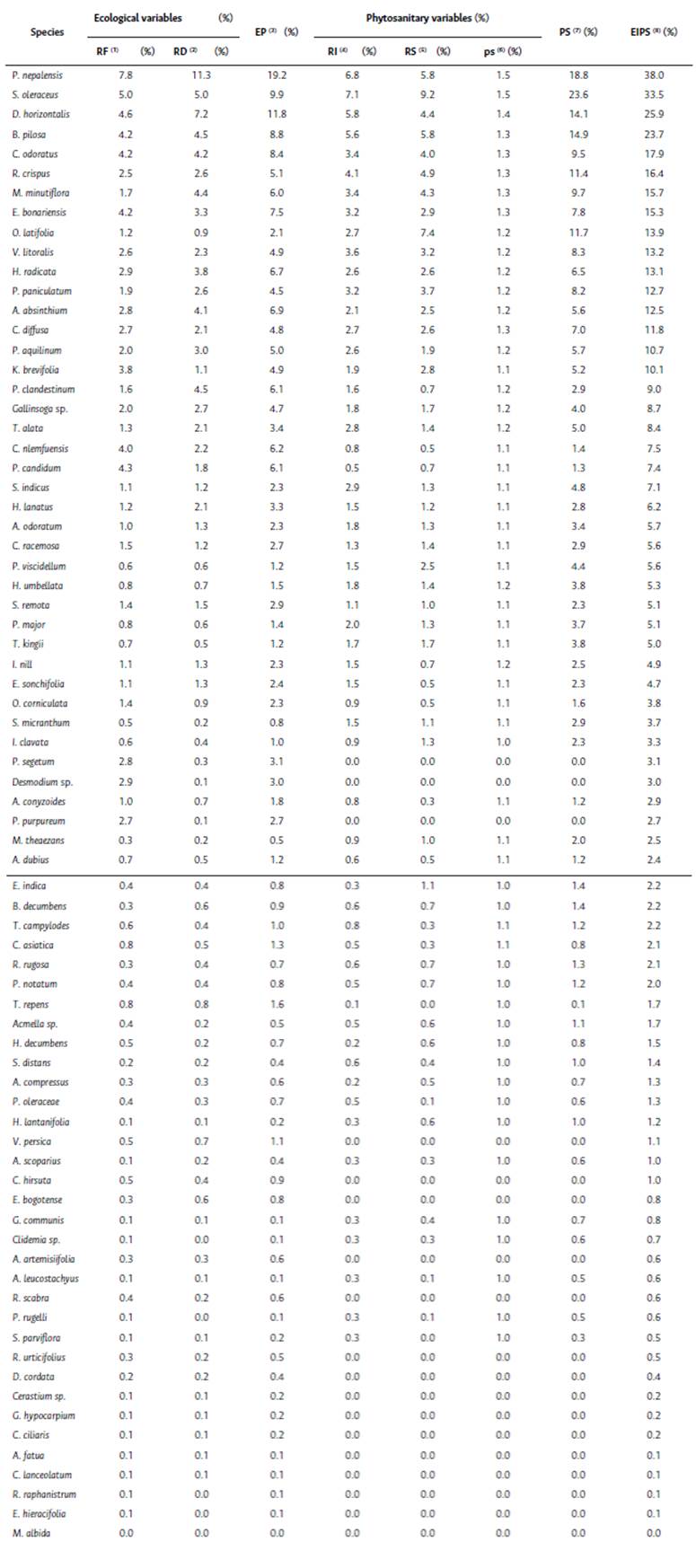
(1) Relative frequency. (2) Relative dominance (3) Ecological parameter (4) Relative incidence. (5) Relative severity (6) Phenological status. (7) Phytosanitary status. (8) Ecological importance and phytosanitary status of weeds.
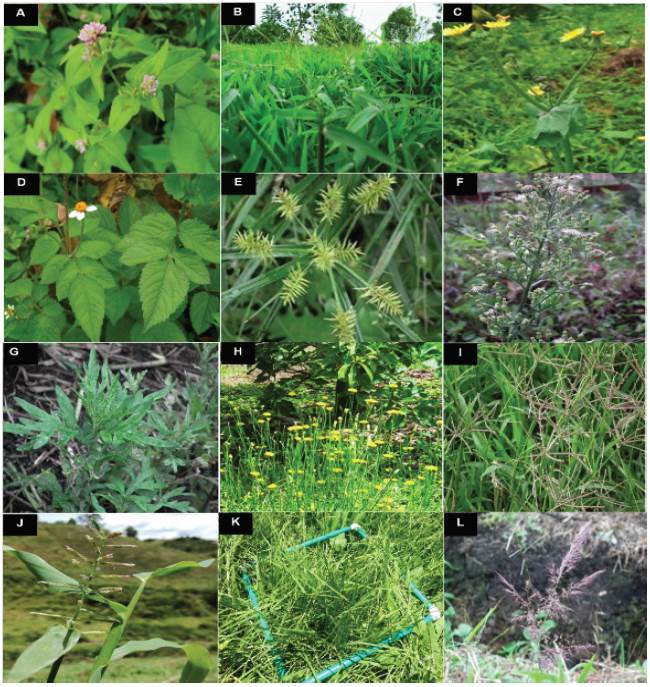
Figure 2 Weeds of greater ecological importance associated with crops in Antioquia, Colombia. A. P. nepalensis. B. D. horizontalis. C. S. oleraceus. D. B. pilosa. E. C. odoratus. F. E. bonariensis. G. A. absinthium. H. H. radicata. I. C. nlemfuensis. J. P. candidum. K. P. clandestinum. L. M. minutiflora.
Phytosanitary status of weeds (PS)
S. oleraceus stood out due to its higher incidence (7.0%) and relative affected leaf area (9.2%), expressing symptoms mainly in the vegetative state (ps=1.5) (Table 5). O. latifolia presented the second-highest value of relative affected leaf area (7.4%); however, the incidence was lower. P. nepalensis, B. pilosa, and R. crispus presented a remarkable relative affected leaf area, with values of 5.8%, 5.8%, and 4.9% respectively; and in this case, with higher incidence values than O. latifolia, which is why the PS parameter places them above in the proposed rank. In general, 76% of weed population presented foliar symptoms of presumably fungal diseases and on average, 63% of these occurred in the senescent state (fs= 1.0 - 1.10), 35% in the reproductive state (fs= 1.11 - 1.40) and 3% in the vegetative state (fs= 1.41 - 2). The twelve species of weeds with the highest PS values are presented in Figure 3.
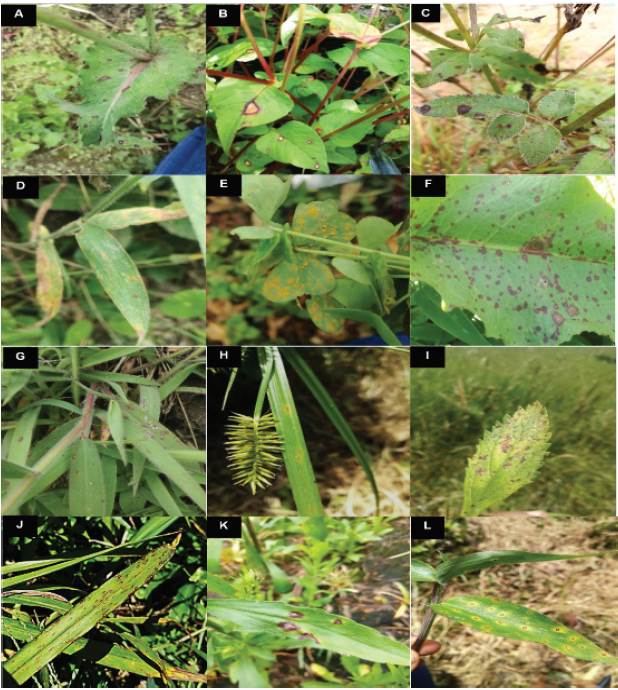
Figure 3 Symptoms of fungai diseases with greater occurrence on weeds associated with crops in Antioquia, Colombia. A. S. oieraceus. B. P. nepaiensis C. B. pilosa. D. D. horizontaiis. E. 0. iatifoiia. F. R. crispus. G. M. minutiflora. H. C. odoratus. I. V. iitoraiis. J. P. panicuiatum. K. E. bonariensis. L. C. diffusa.
Ecological importance and phytosanitary status of weeds (EIPS)
In some species such as P. nepalensis, D. horizontalis, and S. oleraceus, there were simultaneously high ecological representation in the territory and remarkable symptomatic phytosanitary conditions, which allowed them to be located in the first places of the EIPS values (Table 5). In other cases, such as P. candidum with EP= 6.1 and PS= 1.3 values, occupying positions 10 and 39 respectively, which indicates that although it is a dominant species no notable disease symptoms were detected. The third quartile of the indicator (EIPS Q3 = 8.4) was used as the cut-off point, from which the corresponding upper group with 25% of the plants was conserved (Table 6). This group was represented by weeds with the highest value of EP and PS; however, the importance of considering other key aspects concerning weed management in crops is highlighted.
Agronomic parameter (AP)
R. crispus obtained the highest score in the five criteria (10 points), followed by M. minutiflora grass (8 points). Eight weeds reached an average value of 6 points, three an average value of 4, and six species an average value of 2. Among the species that farmers indicated with high management difficulty (> 8 points) were E. bonariensis, D. horizontalis, P. nepalensis, T. alata, P. paniculatum, P. clandestinum, and P. aquilinum (Table 6).
DISCUSSION
Among the attributes that contribute to the success in the ecological distribution and dominance of the species of the Poaceae family that stood out for presenting a greater ecological parameter, are the ease of adaptation, sexual and asexual reproduction, greater photosynthetic efficiency due to their C4 metabolism and the condition that some of these are foreign species, with great invasive potential. In the case of the species of the Asteraceae family, factors such as the high seed production capacity in comparison with other plant families, rapid growth, high germination power, and great ease of seed dispersal stand out, which, added to its intense reproduction cycles in a short time, results in a considerable increase in its permanence in crops and the enrichment of the soil seed bank (Ramesh et al., 2017) (Figure 2). According to the EP, P. nepalensis was the weed of greater importance and ecological distribution, apparently well adapted to this agro- ecological zone in recent years, with a special presence in cultivated areas and wetlands.
Regarding the phytosanitary status, S. oleraceus showed the highest incidence and early severity of symptoms; that is, in a vegetative state. This species has been commonly associated with pathogens such as Oidium sp., and Bremia lactuca L., (Vieira & Barreto, 2006). Concerning weed diseases, it is worth considering that, it is possible that the frequent fungicide application cycles that are carried out during the establishment and the first stages of crop growth, could be playing an indirect role in protecting weeds against the development of possible diseases, from the first stages of development of this. In this study, the only two plants that showed symptoms early in their life cycles; that is, in vegetative they were P. nepalensis and S. oleraceus. In this regard, it is possible to consider the occurrence of other potential factors such as resistance to fungicides, the susceptibility of plants in each phenological state to certain pathogens, environmental conditions during the sampling season, among other aspects that could be considered in the future research.
Although 24% of the population did not present any visible symptom of disease, there is a possibility that they may be asymptomatically harboring important pathogens, and/or that at the time of sampling the environmental conditions were not appropriate for the establishment of pathogenic fungi. On the other hand, the presence and severity of diseases in weeds present in crops are also influenced by anthropic decisions such as chemical versus organic management, frequency of fungicide application, planting distance, crop rotation, etc. To date, no studies are yet known in Colombia that detail the severity with which diseases occur in different weed populations under field conditions. Therefore, the information reported here shows a wide area with exploration potential, which could serve to direct lines of research with different approaches for phytosanitary management and integrated management of weeds.
Concerning the agronomic management parameter, E. bonariensis was identified as the weed with the greatest difficulty to control by farmers, with a score of 9.4/10 (Table 6). Undoubtedly, an important factor in the difficulty of weed management is the tolerance and/or resistance of the plants to herbicides. E. bonariensis has been reported as resistant to the herbicides glyphosate and paraquat, in several countries of the world, including Colombia; these herbicides are precisely two of the most commonly used in the country’s agriculture (Heap, 2021). Other characteristics that were associated with the difficulty of weed management are the ability to regrow after mechanical control, tolerance to acidic soils in the area, inefficiency in manual weeding, and early reproduction. O. latifolia presented relevant participation in the structure of the plant community and significant levels of fungal infestation; However, it was known that farmers do not carry out control work on this weed, because they do not consider it a threat to crops, given its low size and superficial root system. The foregoing highlights the importance of considering agronomic management criteria within the methodology proposed in this research, since biological control studies, in general, must be directed to weeds that represent a real problem in agriculture. In this sense, it is recommended to consider for this objective, species whose MA value suggested in this methodology is greater than 5, as it was observed for the species R. Crispus, D. horizontalis, P. nepalensis, T. alata, M. minutiflora, P. paniculatum, P. clandestinum, P. aquilinum, S. oleraceus, E. bonariensis, B. pilosa, and A. absinthium (Table 6).
Table 6 Rating of biological attributes, management difficulty, and agronomic parameter of weeds of greater importance in crops located in Antioquia, Colombia.
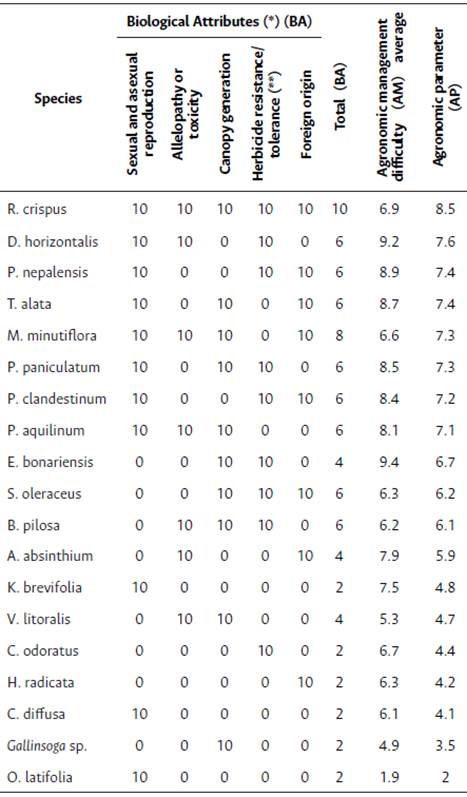
(**) (Heap, 2021)
The methodology used made it possible to select weeds with ecological importance in the population, with the possibility of developing fungal diseases in situ, and that represents a management problem for crops present in the area of study. In research performed in non-agricultural scenarios, such as aquatic, conservation areas, reserves, etc., the choice of species to study may require considering other aspects such as the range of infestation area, intraspecific variation, political or economic conflicts of interest, levels of invasion or displacement of native species, among others (Peschken & McClay, 1995). According to Cárdenas et al. (2017), T. alata, M. minutiflora, and P. aquilinum are classified as aggressive invasive species in Colombia with the ability to displace other native plants and/or to affect forests, grasslands, crops, fallows, and roads among others, which makes them target weeds of great interest.
Selected weeds have been widely studied, which allowed identifying fungi associated with them among which are: Microbotryum nepalense (Liro) Vánky, in P. nepalensis (Denchev & Denchev, 2017); Curvularia sp., in D. horizontalis (Flores et al., 2018); Cercospora bidentis E.J. in B. pilosa (Guatimosim et al., 2015); and Colletotrichum sp., in E. bonariensis (Bonacci et al., 2018). Additionally, in this same region of eastern Antioquia, “Author/a” (2021) reported the pathogenicity of Alternaria thunbergia EG Simmons & Alcorn, and Nigrospora sphaerica (Sacc.) EW Mason on the invasive plant T. alata and Didymella rumicicola (Boerema y Loeraker) Qian Chen e L. Cal., in R. crispus. This information supports the suitability of the choice of these plants for further biological control studies in Colombia, using phytopathogenic fungi as biocontrol agents.
CONCLUSION
This research allowed to contribute to the identification of weed plants of ecological and agronomic impact in the crops of the East of Antioquia, Colombia. Furthermore, according to the proposed methodology, twelve species were detected as potential plants for future biological control studies of weeds, through the use of fungal agents.













